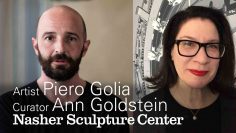Towards a Living Architecture: Architect Philip Beesley
Presented August 29, 2015 at the Nasher Sculpture Center in collaboration with the Ad Astra Lecture Series of the Edith O’Donnell Institute of Art History at the University of Texas at Dallas.
Philip Beesley’s Toronto-based practice PBAI is an interdisciplinary design firm that combines public buildings with exhibition design, stage and lighting projects. Beesley’s work is widely cited in the rapidly expanding technology of responsive architecture. In this lecture, he suggests that conception of buildings can move from classical ideas of a static world of closed boundaries toward the expanded physiology and dynamic for of a metabolism. Working with artists, engineers and scientists, Beesley’s Living Architecture research group combines the crafts of lightweight textile structures and mechanisms, dense arrays of distributed computer controls with machine learning, and early systems of artificial-life chemistry. New installations within the collaboration feature dense reticulated grottos with breathing, reactive, near0living qualities. Recent constructions have included a wide range of scales, from intimate details rendered in clothing for couture, to canopies and construction systems for urban spaces. Details from the emerging work shows a preoccupation with intimate human touch interacting with extremely lightweight materials diffusing into surrounding air. Thin layers of voided hovering filters are turned for delicate kinetic and chemical responses that cohere in the form of expanded physiologies, beckoning and sharing space with viewers.
Philip Beesley is a professor in the School of Architecture at the University of Waterloo in Ontario, Canada. A practitioner of architecture and digital media art, he was educated in visual art at Queens University, in technology at Humber College, and in architecture at the University of Toronto. At Waterloo he serves as Director for the Integrated Group for Visualization, Design and Manufacturing, and as the Director for Riverside Architectural Press. His studio’s methods incorporate industrial design, digital prototyping, and mechatronics engineering. He authored and edited eight books and appeared on the cover of ‘Artificial Life’ (MIT), ‘Leonard’ and ‘AD’ journals. Features include national CBC news. ‘Casa Vogue’, ‘WIRED’, and a series of TED talks. His work was selected to represent Canada at the 2010 Venice Biennale for Architecture, and he has been recognized by the Prix de Rome in Architecture, VIDA 11.0, FEIDAD, two Governor General’s Awards, Architizer A+ Award and as a Katerva finalist. Beesley’s funding includes core CFI, SSHRC, NSERC, TAC, OAC, and Canada Council grants.
The Nasher Sculpture Center’s ongoing 360 Speaker Series features conversations and lectures on the ever-expanding definition of sculpture. Guests are invited to witness first-hand accounts of the inspiration behind some of the world’s most innovative artwork, architecture and design.
Find out more about the 360 Speaker Series and view presentation by past speakers at http://www.nashersculpturecenter.org/360
Stay in touch with the Nasher Sculpture Center via social media:
Facebook: https://www.facebook.com/NasherSculptureCenter
Twitter: https://twitter.com/nashersculpture
Pinterest: https://www.pinterest.com/nashersculpture/
Instagram: https://www.instagram.com/nashersculpturecenter/
Periscope: http://www.periscope.tv/nashersculpture
The 360 videography project is supported by Suzanne and Ansel Aberly. This support enables digital recording of all 360 Speaker Series programs and the creation of an online archive for learners of all ages.
Additional support for the 360 Speaker Series provided by Sylvia Hougland and the City of Dallas Office of Cultural Affairs.









